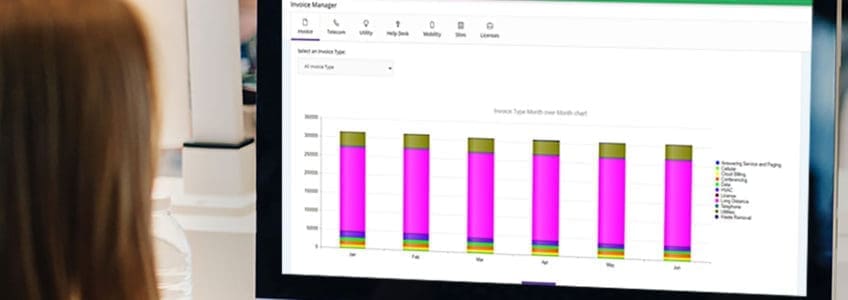How Human Good Achieved a 315% ROI with Radius Point
Discover how one of the America’s largest nonprofit senior living providers partnered with RadiusPoint to eliminate operational waste, drive significant savings, and establish a new benchmark for nonprofit efficiency through a technology-enabled shared services model.
Executive Summary
HumanGood, the sixth-largest nonprofit owner and operator of senior living communities in the U.S., was grappling with a decentralized and inefficient telecom expense management process. This system created significant financial leakage, operational burdens, and service disruptions that impacted over 9,200 residents.
By partnering with RadiusPoint, HumanGood undertook a strategic transformation, leveraging the ExpenseLogic platform and a shared services model to centralize and automate its entire telecom lifecycle.
The initiative delivered transformative results, proving that strategic automation can drive immense value in the nonprofit sector.
Key Metrics at a Glance:
- $360,000 in Annual Hard-Dollar Savings (12% of total spend)
- $150,000 in Annual Labor Efficiencies (soft savings)
- 315% Average Monthly Return on Investment (ROI)
- Invoice Cycle Time Reduced from 30 Days to 5 Days
- 99.9% Invoice Processing Accuracy
The Client: A Mission-Driven Leader in Senior Living
HumanGood stands as a pillar in the nonprofit sector, dedicated to helping older adults live with purpose and joy. Operating over 100 affordable housing communities and 22 life plan communities across five states, the organization serves more than 9,200 residents. As a nonprofit, HumanGood operates with a profound sense of fiduciary responsibility.
Every dollar saved is a dollar that can be reinvested into its core mission: enhancing the quality of life for its residents.
This commitment to stewardship was the driving force behind its decision to address long-standing operational inefficiencies.
The Challenge: A Fractured System Undermining a Noble Mission
Before partnering with RadiusPoint, HumanGood’s approach to managing its vast telecom infrastructure was fragmented and manual. Lacking a centralized system, the organization faced a cascade of challenges that created a significant financial and operational drag.
1. Severe Financial Leakage: The decentralized process was rife with uncontrolled spending. Without proper oversight, unauthorized service orders were common, and inactive services often remained connected and billed for months.
The absence of a unified repository for invoices and contracts made it impossible to audit costs effectively, leading to substantial and unnecessary financial waste.
2. Crippling Operational Inefficiency: The Accounts Payable department was mired in a paper-based workflow that took 20 to 30 days to process a single telecom invoice. This involved manually chasing down data, seeking approvals, and coding invoices, a workload that consumed the equivalent of three full-time staff members.
The process was not only slow but also prone to errors, frequent delays, and misplaced invoices, creating frustration for both staff and vendors.
3. Complete Lack of Visibility: With no central database, HumanGood had no clear view of its telecom assets, services, or contractual obligations. This lack of visibility made it impossible to manage inventory, ensure compliance with vendor agreements, or make informed, data-driven decisions about its telecom spend.
4. Negative Impact on Residents and Staff: The operational shortcomings had real-world consequences. Service disruptions caused by missed or delayed payments directly impacted residents’ connectivity and well-being.
Internally, the frustrating and repetitive manual tasks led to low morale and diverted skilled finance professionals from more strategic, value-added work.
The Solution: A Strategic Partnership for End-to-End Transformation
RadiusPoint introduced a comprehensive, technology-enabled shared services solution designed to address HumanGood’s challenges from the ground up.
This was not merely a software installation but a strategic partnership focused on redesigning processes, aligning technology, and empowering people.
The core of the solution was RadiusPoint’s proprietary ExpenseLogic platform, which served as the engine for automation and centralization.
The multi-faceted solution included:
- End-to-End Invoice Lifecycle Automation: RadiusPoint assumed full responsibility for HumanGood’s telecom invoice lifecycle. The ExpenseLogic platform automated everything from invoice receipt and processing to validation and payment, creating a single, streamlined workflow and reducing the cycle time to just five days.
- Comprehensive Audit and Cost Optimization: The engagement began with a deep-dive audit of all existing telecom services and contracts. This process immediately identified and disconnected inactive services and optimized vendor contracts, yielding immediate hard-dollar savings.
- Centralized Order and Inventory Management: Recognizing a critical gap, the project expanded to include full order management. All requests for new services or disconnections were centralized through ExpenseLogic, complete with automated approval paths and clear audit trails. This eliminated unauthorized orders and created a reliable, real-time inventory of all telecom assets.
- Advanced Analytics and Real-Time Reporting: The ExpenseLogic platform provided HumanGood with on-demand access to dashboards and advanced analytics. For the first time, leadership could see a clear, accurate picture of telecom spend, track performance metrics, and make strategic decisions based on reliable data.
The Methodology: A Framework for Lasting Change
RadiusPoint’s success was underpinned by a hybrid Lean-Kaizen methodology. This dual approach focused on Lean principles to identify and eliminate non-value activities (waste) and Kaizen principles to foster a culture of continuous, team-driven improvement.
The implementation followed a structured six-month roadmap, ensuring a smooth transition without disrupting critical operations.
A cornerstone of the methodology was a robust change management and stakeholder engagement strategy.
RadiusPoint recognized that technology alone is not enough. To ensure adoption and long-term success, they focused on winning the trust of key stakeholders.
- Overcoming Resistance: Resistance from IT middle management, who feared a loss of control, was addressed through education and by demonstrating how automation would serve as an enabler, not a replacement. Once they saw how the platform enhanced visibility and reduced repetitive tasks, they became strong advocates.
- Building Internal Champions: The Accounts Payable team, initially burdened by the manual process, became the most supportive group. Freed from tedious tasks, they championed the new automated system, helping to educate their peers and build momentum for the initiative.
- Data-Driven Communication: The most effective tool for winning support was a “What If” business case presentation that quantified the financial and productivity losses of maintaining the status quo. This, combined with weekly progress reviews and customized dashboards, made the benefits of the transformation tangible and undeniable for all stakeholders.
The Results: A New Standard for Nonprofit Efficiency
The partnership delivered results that exceeded all initial targets, creating a powerful ripple effect across the entire HumanGood organization.
| Metric | Before Transformation | After Transformation with RadiusPoint | Impact |
| Annual Hard-Dollar Savings | Uncontrolled Spending | $360,000 | 12% reduction in total spend from service optimization. |
| Annual Labor Efficiencies | 3 FTEs on Manual Tasks | $150,000 | Staff reallocated to higher-value strategic work. |
| Average Monthly ROI | N/A | 315% | Demonstrates exceptional and sustainable value creation. |
| Invoice Cycle Time | 20–30 Days | 5 Days | 80% reduction, eliminating delays and service disruptions. |
| Invoice Processing Accuracy | Prone to Human Error | 99.9% | Near-perfect accuracy, ensuring financial integrity. |
Beyond these impressive numbers, the initiative transformed HumanGood’s operational culture. It fostered a commitment to continuous improvement, improved cross-functional collaboration between IT, Finance, and Operations, and established a repeatable model for automation-driven efficiency.
This success has not only strengthened HumanGood’s financial position but has also solidified its ability to deliver on its core mission for years to come.
Client Testimonial:
“The transformation was a major value-add, improving cost control, data integrity, and resident satisfaction. The outcome was a fully integrated, end-to-end telecom management process that enhanced financial accuracy, operational visibility, and strategic alignment with our shared services objectives. RadiusPoint’s expertise and technology were pivotal in achieving this success.”
— HumanGood Stakeholder
Transform Your Organization’s Potential into Performance
HumanGood’s story is a powerful testament to what is possible when a mission-driven organization embraces strategic automation.
If your organization is facing similar challenges with expense management, RadiusPoint can help.
Ready to see how much you could save?
- Schedule a Demo – Get a personalized tour of the ExpenseLogic platform.
- Contact Sales – Speak with one of our experts to discuss your specific needs.
RadiusPoint Recognized as a Distinguished Vendor in the 2024 Amalgam Insights Vendor SmartList
For immediate release:
Orlando, FL January 23rd, 2024 – RadiusPoint, a renowned name in the Technology Expense Management (TEM) services sector, proudly announces its recognition as a Distinguished Vendor in the 2024 Amalgam Insights Vendor SmartList. The SmartList, themed “Why TEM Matters More Than Ever in a Cloud, SaaS, and AI World,” serves as a testament to RadiusPoint’s exceptional contributions and expertise in the industry.
Amalgam Insights, a trusted source for technology insights, has distinguished RadiusPoint as a standout performer in the TEM landscape. This recognition reflects RadiusPoint’s position as a premier single-source SaaS platform and Business Process Outsourcing (BPO) service provider. With over three decades of unwavering commitment to excellence, RadiusPoint continues to lead the way in delivering innovative solutions that align with the evolving needs of a Cloud, SaaS, and AI-driven world.
Amalgam Insights states; “Organizations seeking to contextualize telecom, mobility, and IT spend with broader accounting activity, including facilities visibility and ESG reporting, are best positioned to get the most value from RadiusPoint. As companies worldwide emphasize spending accountability within all divisions and, at the same time, require metrics for their social responsibility efforts, they must think beyond managing disciplines in a siloed fashion. Combining telecom, mobility, IT, and facilities administration into a single practice delivers holistic insight while improving productivity, efficiency, and costs,”
“We are honored to be recognized by Amalgam Insights as a Distinguished Vendor in their prestigious Vendor SmartList,” said Sharon Watkins, CEO at RadiusPoint. “This acknowledgment underscores our dedication to providing cutting-edge TEM services and reinforces our commitment to delivering value to our clients in an ever-changing technological landscape.”
RadiusPoint expresses gratitude to Amalgam Insights for this distinguished recognition and looks forward to continuing its mission of excellence in the TEM services sector.
To learn more about Amalgam Insights, please visit their website here.
The full Amalgam Insights Vendor SmartList is available to download here.
About RadiusPoint
RadiusPoint is a leading provider of Technology Expense Management (TEM) services, offering a comprehensive suite of solutions to manage, optimize, and control technology expenses. With over 30 years of industry experience, RadiusPoint is committed to delivering innovative and cost-effective TEM services in a rapidly evolving technology landscape.
Waste Services Case Study: 28% Reduction in Trash Spend
28% Reduction in Trash Spend
Trimming expenses on waste management serves as the initial step in an organization’s sustainability journey. A prominent elevator company operating worldwide successfully slashed its monthly waste expenditure by 28%. Additionally, by securing a corporate contract, they paved the way for greater savings across their new locations, fortifying their commitment to sustainability.
Issues
Our client grappled with numerous challenges in its billing and services. Upon conducting an initial review, it became evident that over 40 locations had individually inked contracts with local waste haulers. Consequently, these contracts staggered in expiration, often incurring hefty early termination fees. This complexity rendered negotiating a unified corporate contract unfeasible within the initial twelve months of gaining contract and service visibility.
Solution
To tackle these issues, the organization teamed up with RadiusPoint. Collaborating on bill processing and payment services for their monthly waste invoices, RadiusPoint unearthed a route toward cost reduction during the standard optimization process.
RadiusPoint’s optimization process delved into scrutinizing services provided by the existing vendor, aiming to uncover contractual obligations and service specifics. Numerous locations had ordered services sporadically without considering contract terms, bin sizes, or pickup frequency. RadiusPoint conducted a comprehensive analysis across the organization, tailoring services to match the office types and specific service requirements to ensure an appropriate fit.
During our inventory and audit of the waste services, RadiusPoint:
- Obtained a copy of the vendor’s current contract.
- Validated the contract rates against the current invoice.
- Compared services across all sites for any anomalies.
- Identified overage charges or other charges beyond the normal pick-up charges.
- Identified better rates for those locations not under contract.
- Identified better rates and possible early termination penalties, if applicable, for those locations under contract
- Recommend service changes to eliminate overage charges.
- Provided consolidated report for Request for Proposal (RFP).
- Provided analysis once RFP is returned to show savings.
- Assisted with contract negotiations for each contract or global contract.
- Managed the transition project.
- Assisted with issues that arose at the location during the term of the agreement.
Results
Partnering with RadiusPoint empowered the client to leverage our exclusive software, ExpenseLogic. This tool facilitated the seamless processing and payment of monthly invoices while concurrently conducting an audit to guarantee precise billing per contracted rates. This meticulous approach culminated in an impressive 28% decrease in monthly waste expenses. Embracing transparency in management paves the way for astute business choices, fostering cost-effectiveness, operational efficiency, and the achievement of sustainability objectives. Entrust RadiusPoint to guide you toward attaining your business savings targets, specifically with your waste services.
Healthcare Case Study: Telecom Expenses Down by 26% in Healthcare
Reducing Telecom Expenses by 26% in Healthcare
RadiusPoint collaborated with an Assisted Living and Nursing Home organization to enhance their oversight of telecom, IT, and wireless expenses. Serving as their telecom expense management (TEM) partner, RadiusPoint offered comprehensive insight into their invoices and spending and the range of services and equipment deployed across each site. This detailed visibility enabled RadiusPoint to identify and deactivate over 700 dormant business lines at various locations leading to a 26% reduction of their annual spend or $475k once the lines were disconnected and removed from the invoices.
Background
Given the healthcare industry’s focus on emergency preparedness, there’s a constant demand for reliable access to emergency personnel. Landlines play a critical role in ensuring immediate response in case of facility emergencies. Each location is mandated to have two copper lines for direct fire notification, with the option to add more lines for direct point-to-point access to the fire department. Safety for patients and staff is the top priority for this organization, necessitating RadiusPoint to meticulously validate vendor-provided information at every site.
Issues
The organization lacked previous inventory and audits of its telecom, IT, and wireless services. The service introduced detailed identification of each service type on vendor invoices, outlining all features, fees, taxes, and surcharges billed for each phone number. Various telecom vendors used different billing formats, with some providing only the total amount due without specific service descriptions or associated phone numbers. This limited visibility hindered effective decision-making regarding service removal or cost reduction through optimization.
As the costs of regular business lines escalated with vendors, the organization faced pressure to cut expenses. However, stringent regulations and safety protocols concerning patient well-being posed a challenge. Over the past two years, regular business line costs surged significantly, soaring from $50.00 to over $200.00 per line. Although newer, more cost-effective technology existed, regulatory restrictions prevented its use for regular business lines, prioritizing security measures.
Solution
RadiusPoint conducted an audit and inventory, yielding crucial information for eliminating unnecessary lines. This initiative validated services and phone lines across all sites, uncovering errors and overcharges in invoices. Some invoices continued to bill for services canceled years ago, obscured by invoice complexity or consolidation. RadiusPoint’s scrutiny pinpointed erroneous charges like features and taxes on phone lines canceled five years prior, prompting requests for credits from the vendor. In one case, even after an account was disconnected, circuits associated with it continued to bill due to a failed disconnection request.
The inventory and audit process began by verifying each phone line’s use through multiple calls and on-site visits for lines without responses. This process revealed over 700 unused regular business lines, some unconnected even in the phone rooms at various locations. Additionally, RadiusPoint offered recommendations to reduce line counts and optimize necessary lines. This enhanced visibility into remaining monthly expenses, enabling contract negotiations with vendors, and resulting in a further 10% cost reduction.
Results
Now equipped with ExpenseLogic, RadiusPoint’s proprietary software, this organization possesses comprehensive visibility into its telecom invoices and a complete inventory management system. In the Site Manager section of ExpenseLogic, a single click grants their team access to detailed invoice images, individual phone lines, circuits, wireless numbers, service features, and monthly costs for each location. Their annual savings exceeding $500k, alongside the elimination of 700 unnecessary lines, have led to reduced costs, improved services, and heightened accuracy in their monthly telecom billing.
Fraud Case Study: Tales of Fraud in the IT Department
Tales of Fraud in the IT Department
Fraud is a significant concern for organizations, with reported cases and financial losses steadily increasing according to the Federal Trade Commission. In 2021, consumers reported losses exceeding $5.8 billion, a staggering 70% increase from the previous year. 2022 numbers are still being calculated, but the trend of rising fraud cases persists annually.
Employee fraud spans various forms, ranging from small instances like expense report manipulation to larger-scale embezzlement. Instances of fraud can persist over extended periods, leaving businesses perplexed about its onset and duration. Often, fraudsters are caught not by the act itself, but due to their escalating greed for increased gains.
RadiusPoint, specializing in Telecom and Utility Expense Management, has encountered numerous instances of fraud. Some cases have been proven and prosecuted by authorities, while in others, suspicions of employee fraud have led to discreet dismissals once RadiusPoint delves into telecom and IT expenses and contracts. The company has also provided documentation and insights to prevent fraud within IT departments or telecom services.
What Kind of Fraud Can Be Lurking in Your IT Department?
Wireless device usage continues to surge annually, fueled by wearable devices and remote work policies that often provide employees with wireless phones, iPads, or similar devices. For large organizations, adding wireless devices is routine, facilitated by negotiated contracts offering discounted purchases and waivers for early termination fees.
In a striking case, RadiusPoint uncovered internal fraud amounting to over $350k tied to monthly wireless device purchases at a healthcare organization. An IT employee exploited the system by purchasing Apple iPhones and iPads through the company account, setting up monthly services under the corporate account, and then selling these devices for personal gain. The scheme involved ordering devices, arranging services, and coding the costs to a specific Cost Center with the manager’s approval. The employee then canceled these accounts without incurring early termination fees, leveraging the negotiated contract terms. The fraudulent activity went unnoticed until RadiusPoint raised concerns about unassigned devices and an outsider inquiring about the excessive device offloading. More than 700 devices were ordered in a short span, resulting in losses for the company, including device costs, the first month’s service, and the ETF. The case gained traction with the involvement of the Department of Justice, leading to the prosecution of the former employee.
Another form of fraud, albeit harder to substantiate, involves a recurring pattern where the approving party consistently selects the same vendor for significant contracts and receives kickbacks in return. This type of fraud poses challenges in proof and often leads to the discreet dismissal of the involved employee. In a recent case of this form of fraud, RadiusPoint conducted an audit for a multi-location healthcare equipment organization, examining data circuits, invoices, and contracts. This revealed multiple contract violations spanning various years and locations, encompassing data circuits, Sonet rings across cities, and an MPLS platform. Initially, the audit led to recovering $300K in contract violations and overcharges from the vendor. Subsequent audits expanded to other services and contracts, uncovering an additional $250K in discrepancies. The employee responsible for negotiating and approving these contracts discreetly vanished from the company.
How Can You Bolster your IT Department’s Defenses Against Fraud?
Establishing a standardized workflow would have significantly mitigated fraud and theft risks. However, several additional policies could reinforce the legitimacy of vendor orders:
- Implementing a uniform Workflow for ordering new services.
- Mandating cost center and individual assignments on vendor order forms.
- Introducing a secondary approval process for equipment orders.
- Verifying equipment purchases through monthly reporting by your TEM provider.
- Ensuring monthly documentation from vendors for new equipment or services approval.
- Sending RFPs to multiple vendors for side-by-side evaluations of proposals.
- Sharing agreed-upon contract rates with the team handling monthly invoice validation.
- Requiring Quarterly Business Reviews to validate billed rates accuracy.
While no plan is foolproof, adhering to specific purchasing and contracting policies can significantly diminish the risk of fraud. RadiusPoint can assist by scrutinizing your invoices and contracts for any potential concerns.
UEM Collaboration Saves Over $1 Million
UEM Collaboration Saves National Home Builder Over $1 Million
RadiusPoint recently collaborated with a national home builder to simplify the process of utility ordering and ensuring installations for more than 5,000 new home projects yearly. During this collaboration, RadiusPoint uncovered monthly billing exceeding $25,000 for homes sold two years earlier and identified over $100,000 in refunds from vendors holding funds for closed locations. The anticipated annual cost savings for this client are estimated to surpass $1 million, based solely on the initial six months of RadiusPoint’s services.
Background
A national home builder faced significant challenges in various areas, particularly in handling utility vendors, invoices, and expenses. With multiple divisions under corporate management and an annual workload of over 5,000 new home projects, each division independently managed meter installations but directed the resulting invoices to the corporate office for payment. This decentralized process led to numerous problems, including multiple service outages that required division intervention to restore services.
Issues
The initial challenge for the home builder revolved around service setup. Several individuals in each division handled order placements, causing delays in meter installation and service initiation, consequently impacting the start of construction projects. Additionally, the lack of a standardized process and the involvement of multiple individuals led to vendors not sending invoices to the corporate office. Often, invoices were mistakenly delivered to empty lots without mailboxes, resulting in returns. Subsequently, vendors would disconnect services, further delaying the work of trade workers on the homes. These complications collectively resulted in significant losses, amounting to thousands of dollars due to decreased productivity.
The subsequent problem concerned accurately tracking expenses related to meter usage. Typically, builders assign charges for individual homes to different accounting codes, enabling corporate oversight across various completion stages. This accounting system also offers insights into the completion date and turnover to the Sales department. However, while the corporate office had a daily method for monitoring home progress and stages, there was no established process to align this information with monthly utility expenses.
Adding to the list of issues was the discontinuation of services after home sales. Although each division was responsible for disconnecting services, this task was often neglected. The process of transferring services to the new homeowner’s name relied on the homeowner, but due to consistent confusion around final permit approvals and multiple contacts required with the vendor, ensuring that the homeowner completed this step was frequently overlooked.
Solutions
Service Order Placement
In their initial interaction with the Accounts Payable department, RadiusPoint pinpointed various issues that could be resolved through their Invoice Processing services, offering improved invoice management and cost allocation. While assessing the current service order process, RadiusPoint identified a fundamental issue underlying most of the problems faced. Leveraging their proprietary software, ExpenseLogic, the RadiusPoint team developed a streamlined service order process for each division. This involved creating a customized order form tailored to the builder’s requirements. The form also featured a link accessible on the builder’s tablet, enabling on-site service order placements.
Another valuable feature contributing to the process streamlining was the capability for the builder and their team to include permits or necessary documents when placing orders with utility vendors for future needs. Many utility vendors require a city government-issued permit before setting up a meter at a property. RadiusPoint incorporated this ability to attach documents to the order forms tailored for each builder’s requirements. These documents are centralized in the Site Manager Dashboard within ExpenseLogic, ensuring easy access not only for the division but also for anyone within the corporate structure. This customized addition significantly reduced the hours spent searching for documents previously held by one individual.
Timely order placement and ensuring prompt meter setups were crucial, and RadiusPoint facilitated this by collaborating with vendors through ExpenseLogic’s Moves, Adds, Changes & Disconnect (MACD) module. This module provided comprehensive tracking of the ordering process and seamlessly connected with the Invoice Processing section to guarantee proper invoice setup and allocation to the correct Cost Center, ready for the first invoice. One significant corporate benefit was the RadiusPoint team’s ability to track missing invoices. Daily Missing Bill reports were generated to identify vendor invoices that hadn’t been received. RadiusPoint then contacted the vendors to retrieve and process these invoices. Prior to RadiusPoint’s involvement, missing invoices could result in the property receiving the invoice after service disconnection, causing site downtime and productivity loss.
Proper Accounting and Allocation
ExpenseLogic functions as comprehensive accounting software, enabling the allocation of invoices to Cost Centers or project codes. Leveraging the builder’s daily report illustrating the 12 stages of home completion, RadiusPoint easily devised a solution for accurate allocation. They implemented a daily import system into ExpenseLogic, aligning Cost Centers with invoice expenses. This method ensured precise monthly expense allocation corresponding to each home’s building stage, facilitating accurate chargebacks and providing enhanced visibility into expenses. Additionally, it offered improved forecasting capabilities for total costs, adding value to the process.
Disconnecting Utility Services
One frequently overlooked aspect was the essential follow-up required after home sales. Divisions were responsible for contacting the vendor two weeks post-sale to confirm the new homeowner’s transfer of electric, gas, and water services into their name. Due to difficulties in tracking the home-building stage, these follow-ups often slipped through the cracks. Compounding the issue, vendors sometimes hesitate to change the account name due to pending permits or final inspections, necessitating additional follow-ups after inspection completion. Failures in inspections further prolonged the process. These hurdles transformed what should have been straightforward into a complicated and time-consuming procedure.
RadiusPoint established a clear timeline for vendor follow-up. By utilizing the MACD module in ExpenseLogic for service orders, the follow-up, including any required documentation, became more efficient. With all stages meticulously tracked, upon receiving subsequent invoices, RadiusPoint ensured the final bill accuracy and requested any outstanding credits, streamlining the process.
Results
The custom processes established by RadiusPoint through ExpenseLogic enabled numerous end users to not just initiate orders but also track home stages, offering clearer insights into utility expenses for each home build. This innovative approach empowered the home builder to reassign staff and, within the initial six months, achieve nearly $1M in savings.
The Perfect Storm
The Perfect Storm for Business Operation Disruptions
Accounts Payable reps in multi-location corporations, such as retail chains and QSRs, encounter numerous disruptive challenges. Despite their diligent efforts, they are often held responsible for these issues. As a CFO, Comptroller, or Accounting Director in a large multi-location business, mitigating disruptive events, especially during challenging economic periods, is a significant concern.
Power Disruption: Impact on Hospice Operations
One of our hospice industry clients recently faced a significant challenge when their office lost power one January morning. Janice, the office manager, discovered the issue when she couldn’t switch the lights on and noticed the cold temperature inside. The power outage meant they couldn’t receive or treat patients. Realizing the neighboring businesses had power, she called the utility company and found out their power was disconnected due to non-payment. Calling corporate, Janice sought answers from Accounts Payable regarding the oversight of the unpaid electricity bill that led to a complete disruption of their daily operations.
In the last two years, this recurring scenario has unfolded in businesses of all sizes throughout the US. Accounts Payable staff are frequently held accountable, despite various factors contributing to disruptions that are unrelated to their department. These circumstances have escalated, becoming increasingly systemic and consistently disruptive to regular business operations.
What are these systemic factors?
Factor #1 – Utility Vendor Invoice Delivery Practices
Utility companies often rely on traditional mail for invoice delivery instead of providing convenient online options, which may sometimes be inadequate for businesses. These invoices are complex, containing service details, meter readings, due dates, and various taxes, ranging from one to multiple pages. While some allow downloads, the process has drawbacks. Businesses must manually remember to retrieve invoices monthly, as there’s often no email notification. Additionally, setting up an account for electronic billing relies on specific personnel, risking missed invoices if they leave or are unavailable, potentially leading to service interruptions due to non-payment.
Factor #2 – Utility Vendor Due Dates
Utility companies often provide payment due dates set between 10 to 20 days from the invoice mailing date. Smaller municipalities usually lack online invoice options, leading to the shortest payment windows. Considering a 5-7 day mail delivery, and additional processing time for payment checks, meeting these deadlines becomes challenging. Even with a 20-day due date, internal payment approval processes can impede timely payments.
Factor #3 – Utility Disconnect Notices
Some utilities issue a Disconnect Notice that warns the business that they will be disconnected on a certain date if payment isn’t received. In theory, this is a good fallback to ensure that services are not disconnected. But when you consider that this Disconnect Notice is mailed out and takes 5-7 days to arrive in the mail, there is a risk that service is disconnected before the notice even arrives.
Factor #4 –Postal Service Delays
The US Post Office, a regular contributor to mail delays, has exhibited this issue for years, even as stamp costs rise. In 2021, they further extended delivery times by 2-5 days, leaving Accounts Payable with very little margin for late payment errors.
Factor #5 – Work-from-Home Policies
Pandemic-related lockdowns have compounded delays in utility invoice payments, leading to prolonged phone wait times for Accounts Payable due to remote work. Representatives often cannot email invoices, opting to reprint and mail, causing a 5-7 day delay, compounded by potential mail delivery lateness. The shift to remote work has significantly disrupted utility and telecom companies’ billing and accounting functions, burdening Accounts Payable, especially in larger companies with multiple locations. For instance, a single location can demand about 4.5 hours monthly for Accounts Payable, escalating to over 100 hours for corporations with 25 locations, posing a significant workload solely to prevent service interruptions, a challenge faced by many departments since 2020.
Future Outlook and Conclusion
We foresee no improvement in that situation moving forward. During a recession, customer-facing and administrative personnel are typically the first to face layoffs. Banks are reducing branches to cut staff costs, while tech companies like Amazon are downsizing significantly, affecting customer service representatives (CSRs). The trend of poor CSR support in the last two years appears unlikely to change in 2023.
RadiusPoint, like other leading utility and telecom expense management service providers, exists to deliver efficient solutions that ensure a measurable positive ROI for clients. Clients outsource invoice processing to us, tasking us with a cost-cutting mission. We handle all tasks, from invoice receipt and auditing to disputing charges, obtaining credits and refunds, and ensuring timely payments to avoid fees and service disruptions. Our role is to cut costs and alleviate the burden on Accounts Payable departments. If interested, reach out to us to discuss how we can assist you in optimizing your expenses. Unlock the power of effective expense management today!
Deep Dive Eliminates Telephone Overcharges
Most organizations with multiple locations will have many telephone vendors that they must deal with daily. Each Telecom vendor will have different service offerings that will create confusion and ambiguous monthly invoices.
How do you keep your organization from overpaying for your services or having the wrong ones in place at each location?
Organizations require telecom services at each location for several reasons:
- Regulatory – fire alarm and elevator lines
- Security – alarm lines for the security system
- Order Management – Point of Sale (POS) over data circuits
- Customer Access – Direct Lines to departments for customers
- Connectivity for location to corporate – Data circuits
- Long distance – Connecting the location to the outside world for long-distance calls
- Wireless Service – Wireless devices for employees
These services will be provided by multiple vendors, which means that there will be multiple invoices for each location, each month. Identifying the best vendor with the best rates is not the beginning of the quest to eliminate overcharges. The beginning is the deep dive that is required to identify what services are already in place and how those services are used.
Most organizations have specific telephone needs that require circuits and copper lines for each location. Keeping up with the circuit numbers, each copper line phone number, and what it is used for is a cumbersome task.
For one retailer, not ensuring that services and equipment were properly cataloged and monitored created an embarrassing situation for the telecom and IT team and overcharges of over $62k paid needlessly by the retailer.
Retailers must have telephone numbers that allow a patron to call a specific department such as men’s shoes or children’s clothing. To have this type of service a retailer needs to have direct lines to each department.
Keeping an inventory of the circuits and phone numbers may have identified that the services were not canceled when the location closed. The other issue that created this overcharge situation was the ambiguous invoice from the telephone vendor.
The billing did not break down the services with enough detail to allow the telecom and IT team to realize that when they requested the services to be disconnected, not all services were disconnected. This oversight caused a 2 year overpayment period of $62k.
So, beyond the obvious of making sure your company is not overpaying for services, why is this deep dive needed?
In the Telecom industry, this deep dive is referred to as an inventory and audit of the telecom and IT services. This inventory and audit should create a baseline of service types, costs, contracts, and invoices.
It should also validate what services you have, the location address, and the department or personnel using the services. Identifying errors, overcharges and inefficiencies in your environment will bring the entire process together to cut costs and increase efficiency.
Having this information detailed by location would have saved this retailer over $60k because when the services were no longer needed and a disconnect request was made, it would have been quickly identified that the services continued to bill.
Identifying the right partner to work with to perform the inventory and audit is a must. There are many organizations that will “audit” your telephone invoices, some only charging for a portion of the savings however, defining exactly what will be audited and what the deliverables should be the first questions asked of your potential partner.
If you need this deep dive to identify very detailed information about your current telecom environment, you will most likely not receive that with a contingency-based model as often these are quick looks at the services to identify the low-hanging fruit.
The deep dive needed to specifically identify all services and their purpose will need to be performed by a project-based company that defines the deliverables with multiple steps and a very detailed work product.
Identifying the information that will be included in the inventory and audit is one of the first steps in gathering the information required and a timeline that will produce cost-saving results. One of the most frequent inventory and audits performed is for copper lines or Plain Old Telephone System (POTS) lines.
These lines are often required for businesses for alarm or elevator lines. Several years ago, this was the best and most cost-effective solution, however, innovation has created new types of services that work better and are much more cost-effective.
A business can transition over to these new services. However, if you do not have an inventory of all of your current services and phone lines, you run the risk of not disconnecting all of the POTS lines and you will keep paying for them.
A recent inventory and audit identified over 600 POTS phone lines that should have been canceled years before, however, the locations continued to pay for the lines because they had no idea the lines still existed.
The services had moved to a more modern service at a much lower cost, but the telecom team performing the work did not realize that the lines continued to bill. This oversight cost this company over $30k per month.
How can your chosen partner prevent this type of oversight from occurring? Identifying all the current services is the best place to start by ensuring that you’re only paying for what you need.
A successful project consists of a framework for managing fixed telecom environments that focuses on people, processes, and tools/technology. The inventory and audit establish a contract, invoice, service detail, and cost baseline.
The visibility gained through the project supports technology selection, budgeting, contract negotiations, vendor relationships, change management, and other integral telecom activities.
What type of information is needed to complete an inventory and audit?
- Location address
- Service contracts
- Invoices
- Customer Service Records
- Organizational information
- Service ordering process
Identifying the services and lines or circuits is one of the most important areas of the project as this is where most of the hidden services are found. Ensuring that an organization is only paying for the services that they want, and need is an integral part of the process and can uncover thousands in savings.
During an inventory and audit for an auto parts after-market organization, it was uncovered that there were 25 toll-free lines billing long-distance calls however the lines did not belong to them.
The lines were billed through the long-distance carrier and were on an invoice that was billed monthly; however, the total invoice cost was over $500k monthly and was more than 1,000 pages in length.
The only way this type of overcharge is identified is by calling each phone line to ask who the line belongs to. Once this occurred, the lines were moved from the organization’s account, saving them $10k per month.
Verifying ownership of the services is the first part of the process and once the services are verified as belonging to your organization, it is necessary to ensure that the monthly charges are accurate.
Identifying where contracts exist for each location is time-consuming but a required part of performing the inventory and audit steps. A quick-service restaurant learned the hard way that obtaining a global contract does not mean that you can set it up and forget about it.
For their 280 locations, the Internet Service Provider (ISP) set up services under contract, however, they set up an incorrect rate plan that caused this client to bill at a higher rate for each location’s Internet service.
The higher rate cost them $16,000.00 for the year, something that they had not budgeted for, and the overage caused financial reporting issues for their locations.
With the various types of services telephone or landlines, wireless, internet, long distance, etc. the steps to complete the inventory and audit are different for each type of service.
Ensuring that your partner is fully versed on each type of service and understanding what steps will be taken to audit each type of service will eliminate issues during the deliverable phase.
Upon completion of the project, you should have a set of these discoveries. It will also give you the baseline of information you need to effectively manage your environment on an ongoing basis, optimizing cost-effectiveness and efficiency.
Completion of this project will provide key insights, revealing what services are installed, where services are installed, what services are invoiced, and how much services cost.
This project will provide you with the comfort of a complete inventory of your telecom environment and will give you the baseline of information needed to manage your telecom environment in the most efficient and cost-effective manner.
With the skyrocketing costs for telecom services and the need for fiscal responsibility in the face of inflation and possible recession, it is imperative that a business consistently monitors their telecom and IT invoices and services.
ESG Reporting: Eliminating 800 Man-Hours of Data Gathering
Many organizations have a workable Corporate Social Responsibility (CSR) plan in place. However, Environmental Social Governance (ESG) will be the new benchmark going forward to ensure that both your organization and brand stay relevant and socially acceptable. How does your organization get ready and stay ready for this very intricate and detailed reporting that is required for electric, gas, and water consumption?
Challenge
A nationwide retailer with over 1,600 locations has required reporting for the electric, gas and water consumption for each one of their locations. The information required must be gathered from the monthly invoices. The time to gather this information manually would have taken over 800 hours which would have involved someone reviewing each invoice for each month and contacting the vendor for the necessary information that was missing from the invoice.
Issues to Resolve
- Time constraints – the reporting is needed during the 1st quarter of the year for the previous year
- Personnel constraints – The Accounts Payable team did not have time which required temporary staff to be hired
- Knowledge Gap – the vendor’s invoices vary from vendor to vendor so being able to read an electric, gas, or water invoice was necessary to get the work completed timely
- Invoice Availability – the invoices for a portion of the required review had been moved off-site and had to be recalled for this review.
Opportunity
Identifying the requirements early in the relationship with RadiusPoint and this client created the perfect opportunity for this client to have the required reporting in advance of the need. RadiusPoint provides the monthly utility expense management services for each of the 1,600 locations from receipt of the invoice to the bill pay portion of the process. This utility expense management also involves energy expense management that identifies the usage in kWh, therms, and gallons to create more detailed reporting. Using the information that was already being gathered from the invoices and adding the additional required information, RadiusPoint was able to ensure that this client had the required reporting by location for each type of service.
Solutions
The data usage that is needed from each invoice is compiled by the chosen ESG company that creates the client’s overall ESG report. Having this accurate data when it is needed was paramount to the client. The data is required during the first quarter of the next year for the previous year which puts a large burden on an already busy Accounts Payable department. RadiusPoint was able to pull together the reporting and provided an ongoing report solution so that the following year, the report would be completed by the last week of January for the entire previous year. This solution allows the RadiusPoint team to review the data and add any missing components on a monthly basis to ensure that all data is reported for the year by the beginning of the following year. This solution alone eliminated the normal delays of trying to identify who would be pulling together this information and when it would be provided.
Once the client looked at hiring temporary staff to pull the additional required data from the invoice, it was determined that this project would involve over 800 man-hours for the 1,600 locations. RadiusPoint’s solution provided most of the required usage data and the RadiusPoint team was able to go through and identify the missing information quickly to populate as required.
Utility invoices are not easily deciphered and having staff to read the invoices and gather the necessary data was a stumbling block for this client. Trying to find the staff that could perform this data gathering task that was knowledgeable about the electric, gas and water services was problematic. RadiusPoint’s team has an ESG department with knowledgeable personnel that easily filled this knowledge and personnel gap for the client.
Having the invoices on hand presented a problem for this client but it was one that was easily resolved by RadiusPoint. All invoices processed by RadiusPoint are electronically attached to the account number and the digital image is saved for up to seven (7) years. Reviewing past invoices was made easy with the information readily available at the click of a mouse.
The Results
Most ESG programs make provisions for reducing the cost of those services, but the “how” to achieve these cost reductions can be hard to predict. Measuring consumption is the first step in the right direction to reducing usage and monthly costs. The monthly ESG management services allow for the client to see the usage information on a monthly basis which in turn allows for necessary pivots that could result in a reduction of usage.
RadiusPoint’s monthly invoice processing and expense management services manage the utility invoice from receipt to payment of the invoice. Utility and telecom auditing are also important parts of the monthly service that allows RadiusPoint to fully manage the entire lifecycle of the utility or telecom invoice and service. This client saved over $48k and received their detailed and required ESG reporting on time.
$1.3M in Telecom Refunds and Cost Savings: Case Study
In this new case study, CEO Sharon Watkins discusses the telecom refunds and cost saving opportunities discovered by RadiusPoint during an Inventory & Audit of the telecom invoices of a global paper manufacturer. This case study highlights the need for organizations to streamline their telecom invoice processing to avoid overcharges and paying for services that telecom operators add to their billing.
Transcript of the video
Summary
In this video, we will talk about how we were able to assist a paper manufacturer, a Fortune 100 company with a global presence, with their mobility management and telecom expense management needs.
To start with results, RadiusPoint obtained telecom refunds of over $450,000 on their wireless expenses in the first year of service. These refunds matched identified overcharges on wireless invoices. The primary challenge of our client was that they did not have the personnel to manage over 10,000 wireless devices and end-users. This was a global situation, the end-users were spread around the world.
The second major challenge was they could just not manage their telecom billing: at that time, invoices came in a box of over 3 feet high. According to our client, it took six people each month to go through these invoices, flipping through pages and pages to verify costs. So they needed assistance with the invoicing side, as well as with managing the servicing of so many end-users.
Inventory & Audit
We assisted our client with our proprietary platform, ExpenseLogic™, getting them set up to audit and process those invoices each month. We identified billing errors, and went back to the telecom operators to obtain all necessary refunds and reconcile the credits back on the bill.
We did identify over $400,000 in telecom refunds the first year. Those came back to the invoice. Then, still in the first year of service, we reduced costs by identifying services that were not supposed to be on their bill, or that Corporate did not want to pay for or authorize their end-users to have on their company phone. We identified over $850,000 in ongoing telecom savings (cost avoided).
Discoveries during the process
During our Inventory & Audit process, we discovered several major anomalies. For instance, the organization was still paying for phones (and services) for employees no longer on the payroll. Some of them had given their company phone to their children, and our client was still paying for them phones though these ex-employees had not worked there in two years.
We also identified instances when employees were downloading services (apps) — basically almost every phone had paid-app downloads — that were not authorized by company policy. However, since our client had no way to audit the bills, they had no idea their staff had downloaded those extra apps.
Initial TEM mission
Initially, RadiusPoint was hired by this client to perform a one-time audit, Then we continued on with monthly services for Telecom Expense Management and Mobility Expense Management.
Telecom refunds & savings
Q: Where did the $1.3 million in saving come from?
A: The $1.3 million came from two areas. First, we got over $400,000 in telecom refunds. During the first leg of our mission, as we were performing our Inventory & Audit process, we identified what actually belonged to the client, and disconnected what did not belong to them.
Second, going forward, we made recommendations that resulted in another $800,000 in telecom savings. Our recommendations aimed at cutting costs, consolidating the wireless operators, and optimizing contract rates.
That’s where the $800,000 [and ultimately, the $1.3M] came in.
TEM mission follow-up
Q: Does the client continue saving money on their telecom expenses?
A: Our client does continue to save money on an annual basis through our Telecom Expense Management services and the refunds we identify. It’s no longer a historical audit because the service occurs on a monthly basis and as the telecom invoice comes in, it is audited through our ExpenseLogic software platform. We then go to the vendor and reconcile. So yes, they continue to save money on a monthly basis.
Additional resources and references:
These links provide additional relevant information on our services and client feedback.
RadiusPoint and Telecom Expense Management: Our Presence in the Gartner Market Guide
TEM services: One of the two core business lines of RadiusPoint
Next case study:
Click here to discover how a glass manufacturer saved $100K on telecom expenses using RadiusPoint services
In this new video case study, Sharon shares how RadiusPoint helped a global glass manufacturer with large retail operations in the U.S. to overcome a lack of procurement framework, and curb their telecom expenses by $100K+ in Year 1 to get a ROI of 200% on TEM services.
Glass Manufacturer Saves $100K On Telecom Expenses
In this video case study, Sharon shares how RadiusPoint helped a global glass manufacturer with large retail operations in the U.S. to overcome a lack of procurement framework, and curb their telecom expenses by $100K+ in Year 1 to get a ROI of 200% on TEM services.Read More
TEM Process Automation Saves $100K to QSR Chain in Year 1
RadiusPoint helps organizations manage spends quickly and conveniently. In the case details below, learn how RadiusPoint saved a retail client from overspending valuable telecom dollars. Case Background: Nationwide restaurant chain with 240 restaurant locations and…Read More
How Managed Mobility Services Cut Costs 22% ($400K in Year 1)
A food service company with a wide array of locations, distribution facilities, food plants, farms and ranches had hundreds of wireless devices to manage. Unfortunately, our client had no wireless procurement policy framework, and no structure for adding new users to their plans or for procuring new devices. Hence their decision to hire RadiusPoint to rationalize their inventory of devices and lines. This was an MMS mission, a specialty in which we have a long-running experience.Read More
Telecom Service Outages: How to Avoid Them During an Acquisition
Telecom service outages often occur when an organization divest a part of its business…Read More
Inventory & Audit
In this video about the telecom Inventory & Audit process, Sharon Watkins, CEO…Read More
$100K+ in Cost Savings with TEM & Support Desk Services
This case study shows how a manufacturer succeeded in generating cost savings of…Read More
Vendor Managed Services: Why Tread Carefully
Each year, new vendors enter the telecom managed services market, offering what is called…Read More
Loss Prevention Program Cuts Costs at 10,000 Retail Locations
This case study shows how RadiusPoint managed a retailer’s loss prevention…Read More
Wireless Discovery and Optimization Saves $830K Annually
Managing wireless invoices for tens of thousands of users gets complicated and expensive…Read More
Utilities Expense Optimization Saves as Much as 13%
Clients outsource their utility invoices to RadiusPoint to identify savings opportunities they are unaware of…Read More
Overcoming Inflation-Driven Budget Woes With Cost Cutting
Commodity prices have hit historic highs and continue to climb. Businesses are grappling with supply chain disruptions, an energy crisis, and higher wages stemming from labor shortages. Today’s inflationary environment will be with us for some time. This confluence of challenges requires decisive steps to adjust prices, seek new sources of growth, and pursue aggressive cost cutting…Read More
A Due Diligence Process is Essential – M&A Support Services
Already bought and sold twice, a retailer that was on the market again for sale. The third buyer performed…Read More
Driving the Acquisition Transition Phase: Role of M&A Support Services
“Driving the acquisition transition phase” is key to achieving the financial objectives of an M&A…Read More
Inventory Management Uncovers Hidden Assets and Services
Inventory management is one of the eight cornerstone functions of ExpenseLogic®…Read More
Vacancy Cost Recovery Decreases Utility Expenses by 12%
Vacancy Cost Recovery is a significant part of the issues faced by property management..Read More
Managed Mobility Services: Top 3 Differentiators Between Providers
A multitude of managed mobility services (MMS) providers have appeared…Read More
Vendor Billing Audits for a Nationwide Landscaping Company
Technology and utility billing audits remain a primary focus of RadiusPoint’s core expertise as we continue…Read More
Contingency Fee Pricing Model: Beware
If you heard the term “contingency fee pricing model”, did you ever wonder which party…Read More
Utilizing RadiusPoint for Vacant Cost Recovery
A term described to aid property owners in recovering costs associated with tenants…Read More
Facilities Management: 3 Plans to Yield Cost & Energy Savings
Facilities management is the body of knowledge and practices implemented to ensure the functionality…Read More
Cost Reduction Plan Saves 2,000+ Man-Hours
Any cost reduction plan implemented in the context of an acquisition or a divestiture must take into account…Read More
Mergers & Acquisitions: A More Seamless Integration Process
Mergers & acquisitions tend to generate their own margin-depressing cascading effects at Procurement…Read More
Bill Audit + e-Procurement: Cost Savings of 37% on Water Delivery
This case study shows how a bill audit carried out by RadiusPoint, associated with the use of an e-Procurement portal…Read More
Technology Expense Management on a Single Platform: Results
Technology Expense Management service providers like RadiusPoint agree on…Read More
Invoice Audits – Which is More Beneficial: One-off or Monthly?
When evaluating invoice audit frequency requirements in the process…Read More
TEM-UEM Services: 370% ROI for our Clients in 2020
RadiusPoint, a BPO service provider and a leader in the TEM-UEM services industry….Read More
Shipping Cost Optimization Saves $1.1M Annually
Shipping cost optimization has become a major priority for the logistics, transportation, retail & wholesale…Read More
Inventory Management Helps Recovering $174K in Credits
Inventory management is one of the 8 cornerstone functions of our SaaS platform, ExpenseLogic…Read More
Missing Due Diligence Inventory Adds $15K to Acquisition Cost
When making an acquisition, it pays off for the acquiring company to add a due diligence inventory of…Read More
Normalizing Invoice Processing and Payment in Hyper-Growth Phase
This case study focuses on what RadiusPoint did to avoid the straining of the invoice processing and…Read More
Streamlining Invoice Processing for a Healthcare Client
As part of its telecom/utility invoice processing, expense management and process optimization services…Read More
Utilities Mismanagement Costs $18K in Unnecessary Expenses
Utility management is one of RadiusPoint’s BPO specialties. An eye glass retailer-manufacturerRead More
$1.3M Savings Generated Across 5 Acquisitions
Discussing mergers and acquisitions, accounting and consulting firm Deloitte stated…Read More
Audit Uncovers Unrealized Cost Savings of $250K+
This case study focuses on the potential for cost savings stemming from a…Read More
Vendor Management: 13.6% Savings on Cleaning Services
This vendor management case study is a good example of how RadiusPoint helps large organizations generate…Read More
Social Governance – Distraction or Unavoidable Requirement? An Analysis by RadiusPoint
Social Governance (ESG) will be the new benchmark going forward to ensure that both your organization and brand stay relevant and socially acceptable.Read More
BPO: TEM/UEM/MMS Services with a SaaS Platform
Organizations face a slew of factors affecting their employee’s ability to manage successfully the services and…Read More
Mergers & Acquisitions Management/Cost Avoided Case Study
According to Deloitte, “Corporations and private equity firms pin the most blame on external factors, but…Read More
SaaS Spend & Cloud Spend Management Results in Cost Savings
G2 defines Cloud Spend Management Software as: “Software [that] helps companies reduce…Read More
Finding Hidden Money in your Trash
Are you ready to kick trash overcharges to the curb? Are you paying attention to your company’s trash costs?Read More
AP/Ordering Process Automation Nets 448% ROI
Healthcare organizations are contending with increasing costs, decreasing revenues…Read More














































